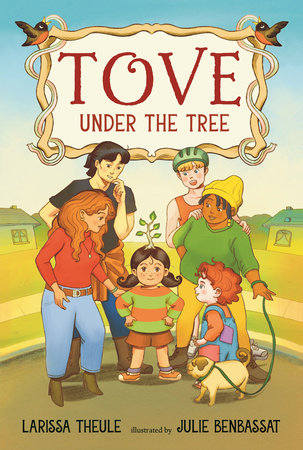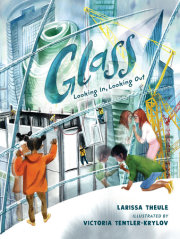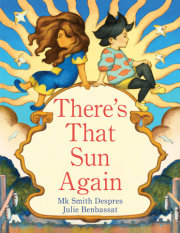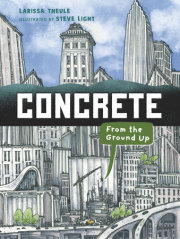Chapter 1One Friday afternoon, Tove came home from school to find the giant ficus tree in front of her house cut down and lying on the ground.
Tove stood still as stone and stared as the city arborists used chain saws to chop the tree into smaller bits. The arborists fed the smaller bits into a wood chipper that made a loud grinding noise.
That tree had shaded Tove’s bedroom during the day. At night, it had held up the stars.
The boss arborist came over to Tove. “It was dead,” she said. She unwrapped a stick of gum and folded it into her mouth. “Trees die. People think they live forever, but they don’t. And the hotter temps are tough on old trees.”
Tove pointed to a little ficus branch that hadn’t been fed into the chipper. It had a single green leaf on it. “That little branch isn’t dead,” she said.
The arborist looked at the branch. “You’re right. That little twig still has some life in it.”
“So the tree wasn’t all the way dead.”
“Technically, the tree is dead.”
“But that little branch isn’t.”
The arborist shrugged. She said, “The city will plant a new tree in this same spot. Residents get a say in which trees get planted. Would you like one with flowers? A jacaranda tree, like they have on Del Mar Street?”
“Jacaranda flowers smell bad when they drop,” said Tove.
“They do,” agreed the arborist.
“I want the tree that was here,” said Tove.
“Sorry, kid. Nothing I can do.”
Tove walked over to the little ficus twig with the single green leaf and picked it up. “I’m keeping this.”
“A memento,” said the arborist, nodding. “If you do decide on a tree you want planted, give me a call.” She dug a business card out of a pocket in her overalls.
Tove watched the arborists pull away in their trucks, dragging the wood chipper behind them.
Thinking hard, Tove tucked the business card into her pocket and went into her house holding the twig.
Chapter 2Tove hung up her backpack, then slipped out of her school shoes and lined them up next to her soccer cleats. She put on her slippers.
Grandma Harriet was in the living room, asleep in front of the TV. Grandma Harriet watched Tove after school on weekdays. On the table beside Tove’s grandmother stood a vase of freshly cut lavender and eucalyptus. Beside the vase was a pair of gardening gloves. Beside the gloves were some pruning shears.
Tove went into the kitchen. She cleared the table of magazines and books and set the little branch down. “Wait here,” she told it.
Tove washed and dried her lunch box. She put in a load of laundry. She made herself a banana and peanut butter sandwich and poured a glass of milk. Then she sat at the kitchen table and studied the little branch while she ate.
The little branch was brown on the outside, white on the inside. It was flexible, not brittle, and it smelled nice. Its one leaf didn’t have any caterpillar holes or dead spots, and it was soft.
However, the little branch didn’t have roots. That was the problem. How could it grow if it didn’t have roots?
Tove thought about the chain saws and the wood chipper. She thought about Grandma Harriet’s pruning shears.
Could Tove get the little branch to grow roots? Where could it do that without being disturbed? Where would it be safe from chain saws, wood chippers, and pruning shears?
Tove finished her banana and peanut butter sandwich. She drank the glass of milk down to the last drop and set it on the table with a light thunk.
She had an idea.
Chapter 3Tove cleaned the kitchen sink and counters and laid out a fresh dish towel.
She washed her hands, counting to fifteen, twice.
After rinsing off the branch, she set it on the towel and let it air-dry.
She filled three glasses of water. She guessed she would need only one but wanted to be prepared in case she needed more.
She tightened her pigtails and put on swim goggles.
Leaning over the sink, she held the little branch to her head with one hand so that it was nice and straight. With her other hand, she poured one of the glasses of water over her head, where the branch met her scalp.
Nothing happened, but she was not discouraged.
She poured a second glass of water over her head.
Still nothing happened.
She considered being discouraged but instead asked herself questions.
Was she missing something?
Was she attempting science or magic?
If it was science, magic couldn’t hurt, could it?
Should she say something while she poured?
As Tove upended the third glass of water over her head and the branch, she murmured a string of the most powerful words she could think of. “Mama, Grandma Harriet, me, home, love, music, trees, the moon, stars, lavender, churros, sunshine, soccer, clouds, friends,
stories—”
There was a tickle at the top of her head.
Something was happening.
Another tickle.
Tove’s brain vibrated like a phone. The little branch was asking for permission to grow.
Tove straightened. “Yes, please grow,” she said.
Just like that, her head accepted and welcomed the branch’s polite, exploring baby roots.
More tickling.
While the branch settled in, Tove took another dish towel from the drawer next to the stove and cleaned up the water that had spilled on the counter. She hung the towel from the stove handle and went to the bathroom to look in the mirror.
The branch on her head looked small but healthy and strong, too. It already had a tiny new leaf! It wasn’t just a branch anymore. It had roots now. It was a proper, tiny tree.
Tove was pleased but knew her job wasn’t done.
The tree needed something like soil, which Tove’s head provided, and Tove would make sure it had enough water. Now it needed sun.
Tove glanced out the window. Some daylight remained.
She left a note for Grandma Harriet.
Dear Grandma Harriet,I am taking a walk in the neighborhood in orer to absorb sunshine. I will be home soon.Love,Tove
Copyright © 2025 by Larissa Theule; Illustrated by Julie Benbassat. All rights reserved. No part of this excerpt may be reproduced or reprinted without permission in writing from the publisher.














